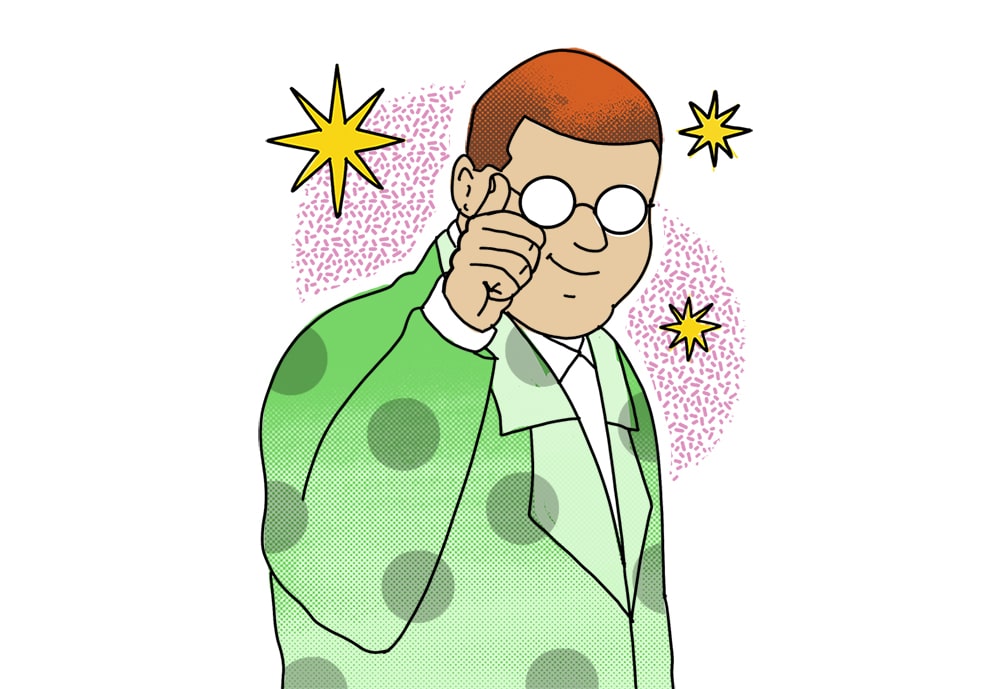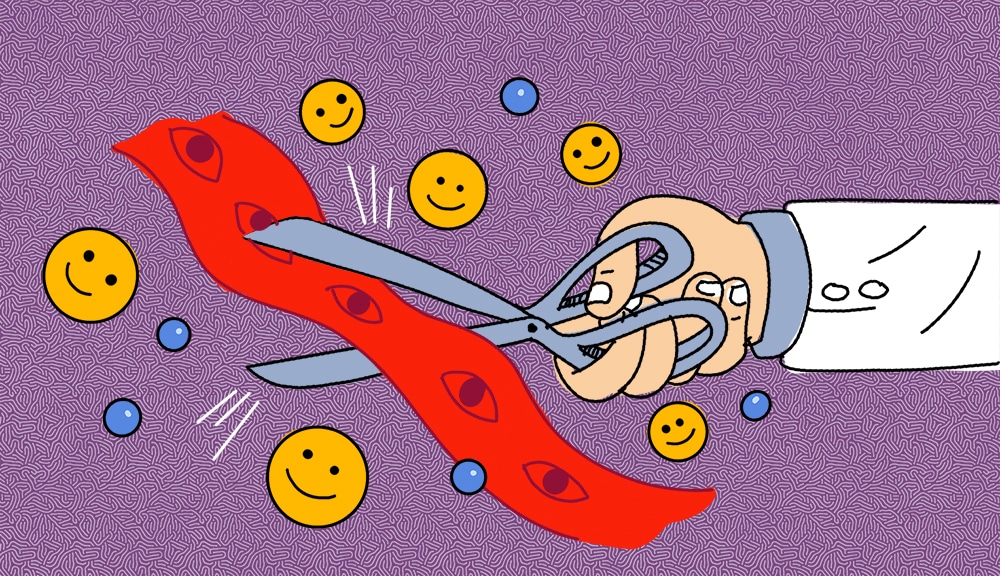WHETHER WE REALIZE it or not, most of us have mixed feelings about creativity, bold ideas and striking out in new directions. We admire the spirit, but when it comes to our own lives — and those of friends, families and colleagues — our true, timid selves often win out. “You can’t do that,” we say, or think. “That’s not how it’s done.” Thinking outside the box is generally accepted as a positive in our society. But most often, when we’re planning our business strategies, or hiring, or deciding what frames our clients are willing to pay for, let’s face it: most of us submit to conventional wisdom, usually out of fear. Most, but not all. In the following profiles, INVISION celebrates six ECPs who came up with a bright idea, faced a storm of negativity, and backed themselves to put it into practice — with truly inspiring results.
They told me I couldn’t… PLAY COLLEGE BASKETBALL AND
GET INTO OPTOMETRY SCHOOL
Scott Mann, OD
Invision
Christiansburg and Salem, VA
When Scott Mann told people he planned to play for the college basketball team while also achieving the grades he would need to get into optometry school, they told him to pick one or the other. As for doing both successfully, “There is no way,” he was told. The thinking, Mann recalls, was that “You either play college sports or you concentrate on your studies.” But he was passionate about both, and in an early example of the determination that would see him go on to create a successful two-location optometric practice in Virginia, Mann took the warning as motivation. He successfully completed his undergrad degree with a joint major in biology and chemistry while playing forward in 100-plus games over four years at the University of Lynchburg at a time — this was in the late 1970s and early ’80s — when the “dumb jock” stereotype prevailed.
“Full disclosure,” says Mann, “I probably didn’t help this. I typically showed up to class with nothing but a few pieces of paper folded up in my back pocket. What most classmates did not know was that same day I went back to my room and copied those notes meticulously in a ‘real notebook’ with details, drawings and comments. That was how I actually studied in college.”
Mann’s main challenge was time management. He had to be out of class by 2 p.m. for afternoon practice, so all his classes had to be finished by 2. Practice took up the afternoon and time had to be allowed for traveling to games. With the basketball season bridging both college semesters, plus off-season workouts, almost every day involved the sport to some degree. “It simply took discipline to carve out study time most days. If time was managed properly there was still time for fun. Trust me I did not skip that part of college!” Mann says.

Most of the “There’s no way he can do that” comments were not said to Mann directly but relayed to him by others. The school’s Sports Information Director, whom Mann had befriended, encouraged him while sharing a few stories from naysayers. A former teacher had a son in medical school; according to the son it was “not possible to play sports in college and get the grades for grad school.”
Mann’s response? “Just to keep going forward. Sports and academics can be like other parts of life; sometimes you just have to grind it out!” He didn’t dwell on the negative comments. “Life is too short for that, but I do believe they motivated me on some level. I had doubts like anyone else but my philosophy is to take the energy you might spend on worry and channel it into working on your goal!”
The abiding lesson of Mann’s disciplined pursuit of his twin passions at college was to “Work hard and play hard.” Without allowing yourself to be mired in ill will towards the naysayers, he says, “It’s OK to let the comments motivate you. Be thankful for your family and close friends who have your back; cultivate those relationships. Bring positive energy to all aspects of your life in an authentic, genuine way. Manage your time. Build in downtime and have some fun.”
Some of the relationships Mann fostered in those days of youthful energy and ambition survive. Four decades on, Mann’s college coach and his wife still drive one hour so he can check their eyes every year and catch up, he says. “That means a lot.”
Advertisement
They told me I couldn’t…HIRE AN ‘UNATTRACTIVE’ SALESPERSON
Cindy Henderson
Eyear Optical
Chattanooga, TN
Answer this question honestly: Have you ever thought twice about hiring someone for a frontline sales position who was frankly “unattractive” in the media-propagated, normative sense of the word? If they included a photo with their application, might you push it to the back of the pile, or offer them a less public-facing position?
You might honestly be able to answer with an indignant “No, never!”— and props to you if that’s the case. But our gut tells us most managers try to hire people who are not displeasing to the eye, just as they try to keep their storefront fresh and appealing. But at what point does sensible discretion become discrimination? It’s an issue Cindy Henderson of Eyear Optical found herself grappling with some time back when she overruled a chorus of objections and hired someone who didn’t fit the mold of attractive and thin to work sales. Sadly, fatphobia remains one of the few remaining acceptable biases for many. Among the complaints Henderson heard were: “Can they fit behind the displays? Can they move quickly enough to handle busy times? Can they move in the lab between the machines?”
She wasn’t necessarily surprised by such views. “‘Conventional wisdom’ always leans toward the ‘Barbie and Ken’ picture when hiring,” she says. “Tall, beautiful and intelligent works in every industry. While opticianry is certainly medical, it is also fashion, and having someone attractive selling the product tends to drive sales even if they’re not the brightest.” And media impact our perceptions, whether we admit it or not. “Advertisers don’t put a troll in their pictures.

They find a ‘hot’ man or woman to sell their products.”
But she was convinced that a good eyewear salesperson is one who knows their products and has a passion for giving people excellent service and eyewear. She went ahead with the hire and found that, far from being put off, “People loved having an ‘imperfect’ relatable person who understood their difficulties. The average person in the U.S. is overweight but fashion tends to ignore that … even in the optical industry.”
Times may be catching up with Henderson’s open-mindedness. “In this difficult time of hiring I have noticed more and more that previously marginalized people are being hired. Men and women with obvious challenges, whether physical, mental or developmental, are working in jobs that would never have been an option for them three years ago.” And while she’s still not able to take any applicant seriously who comes in to interview in cut-off shorts and a tank top, “if they come in and they’ve obviously tried to make a good impression, then I want to give them the opportunity … regardless of weight, gender, race, background, religion, sexual orientation, tattoos, etc.”
Henderson doesn’t begrudge the doubters. “They were reasonable, practical questions.” She acknowledges, in fact, that there were times when the employee in question was kept out of the office by health issues, some weight-related. But solutions were always found.
At the end of the day, the employee met Henderson’s chief requirements for optical sales staff: “To educate the consumer so they can make the best decisions for their vision, lifestyle and comfort. The desire and passion have to be there or the salesperson is just going to be an order taker. McDonald’s is hiring. I can teach optics and technology. I can’t teach caring.”
Going with her gut turned out to be the right decision, says Henderson. “The person in question worked for us for over 10 years. He is incredibly intelligent and well-spoken and has been a great asset to our company.”
They told me I couldn’t…SELL UNIQUE, INDEPENDENT
FRAMES IN A RURAL MARKET
Scott Keating, OD
Vision Trends by Dr. Scott Keating
Dover, OH
Prior to opening Vision Trends by Dr. Scott Keating in a semi-rural location in Dover, OH, a decade ago, Keating visited many optometric offices and could tell there was a niche to be filled in fun eyewear. “I remember hearing so many doctors saying at conferences how they needed to sell lower-end eyewear to meet the needs of their population, but I felt there was an untapped population pleading for cool frames. I was also tired of the gloom and doom I was hearing but nobody was doing anything about it.” Specifically, he was told the unique independent frames from all over the world — some of them higher priced — that he had his sights on would never work in Tuscarawas County, whose 92,000 souls have a median household income of $42,000. Surrounded by a high population of Amish communities and a mix of rural land and small factories, Dover itself is home to just 12,500.
Undeterred, Keating envisioned an optical that, while not necessarily “high end,” was known for its unique eyewear. “I wanted people to say [to his patients], ‘Where did you get those glasses?’ I started paying attention at the Vision Expos for eyewear that was unique, in the right price range, and from solid reliable companies.”
To begin with, he kept independent frames to 40% of his stock, “just in case it started out slower.” He soon realized that he needn’t have worried. “I quickly saw how people loved my different frames and changed my percentages of unique eyewear.”
Keating knew he needed the right price mix, one that reflected the demand for quality eyewear he had discovered, but which didn’t totally lose sight of economic realities. “It would not make good business sense to have all high-end frames but it does make sense to have several [such] companies. These needed to be special and stand out to make them worth the cost.” High-end now makes up 20% of his board space, with 50% allocated to mid-range, which Keating classifies as $230 – $380 based on his local demographic. “Tons of independent companies with unique frames fall into that area. I make sure to also have a solid collection of frames to fit lower budgets. I know we can’t make all budgets happy but we sure try.”

Implementation of the strategy saw an explosion in growth. He now gets people traveling to see him from the big northern cities. “Our patients are walking advertisements,” says Keating. “I also try to carry a decent selection of men’s unique frames. Men are definitely overlooked.”
Vision Trends by Dr. Scott Keating now carries about 40 frame lines including a healthy variety of independents. “Some people think I’m crazy to have so many but patients love so many options. If we carry a very unique and maybe harder-to-sell line, I may only display 12 – 15 frames. I feel that is the lower limit in order to give a decent representation.” If a frame line sells very well in the mid-range, then he may display 45 or more. Getting the right mix of price and frames displayed is crucial and comes down to demographics, he says. But “only carrying 20% unique frames will not set you apart.”
Keating says he had very few doubts at any stage because he was careful about the mixture of frames starting out and was wise about retail price levels. “I just knew if I could find the right independent companies, it would work. My lesson from this experience? Sometimes you just have be like the old Nike slogan: ‘Just Do It’.”
Advertisement
They told me I couldn’t…HAVE A LEARNING DISABILITY
AND OWN MY OWN BUSINESS
Julie Uram
Optical Oasis
Jupiter, FL
For Optical Oasis owner Julie Uram, running her own business is more than just the realization of a dream; it’s a daily repudiation of the negativity that came her way as a child taking classes for kids with learning disabilities — negativity not just from peers but from many of the supposedly responsible adults in her life who should have known better, and who failed to see the potential that in retrospect seems obvious. (No less importantly, it’s also a story of inspiration for those of you out there who have struggled to pass the National Contact Lens Examiners (NCLE) exam!)
“As a young girl I was always considered dumb,” recalls Uram.
“It’s funny because recently I came across old report cards that the teachers gave to me to give to my mother and what those teachers wrote about me … it’s horrible. Luckily, I was the kind of girl that when you asked me to give it to my mom I did and I never read them but I did have people say things to me growing up. So it’s amazing that I have opened my own optical store and have run the store myself for over 20 years.”
The fact that she had difficulty learning the traditional way was a challenge her teachers didn’t want to deal with, she now recognizes. “My mom told me a teacher called her and said she felt I had a nervous disorder. My mom said, ‘What do you mean?’ She said, ‘Julie will swing her legs back and forth in her desk chair like on a swing.’ Mom said, ‘Julie could be eating an ice cream cone and do the same thing — that’s Julie!” Looking back, Uram believes such experiences strengthened her. “When you’re a kid you do recognize disrespect and hate —which is good.”
Some of the negativity obviously left its mark, however; at school and growing up it never occurred to her that she might one day own her own business. It wasn’t until she crossed paths with a beloved mentor figure that she began to see the possibilities. “I started working at the age of 14 and my wonderful boss was my neighbor Wally. He really was a stepping stone for me and my work ethic. He taught me so much — I didn’t even know how to count change. I would open the shop up at 6 A.M. alone and had the key to the castle, as I say.”

The experience gave Uram the confidence to pursue bigger dreams, and in the early 1990s she completed an opticianry apprenticeship in Jupiter. It was an opportunity to put her work ethic to good use. To complete the program she had to work 6,240 hours, which she found a breeze, because she loved the work and put in six days a week. But with apprenticeship came the challenge of certification. She passed the ABO the first time but the NCLE proved a little more challenging, with Uram cracking it on the seventh attempt — a tribute to her determination. The NCLE was always going to be harder for her, because CL fitting was not something she had tackled as an apprentice. “I knew to become an optician in Florida you have to pass the test, so I took it every chance I could. I even listened to tapes while I slept. It was definitely a non-addictive sleeping pill. My encouragement came mostly from my mom.” The ABO, on the other hand, is totally different. “To become board certified I just had to show up and listen, so that was easy for me: no test. I have an issue with reading and comprehending. It was a weekend course; I make a joke about it that I was bored — that’s why I’m ‘board’ certified.”
Uram is modest about her achievements — perhaps to a fault. Whenever she encountered challenges in life, she says, she just looked at them as “something to overcome; I just did it until I conquered it. Life is a lesson. I just live life and try to be the best soul I can be.”
Looking back on her achievements for this article, Uram seemed prepared, if only for a moment, to take some credit for them. “I am one who is determined to conquer my goals. Now that I’m saying this to you, I feel I need to pat myself on the back a little more than I have.”
They told me I couldn’t…HOLD A TRUNK SHOW DURING A PANDEMIC
Elizabeth Bouravnev
Bergh-White Opticians
Springfield, IL
“Party” and “pandemic” are two words that don’t go together. But the whole act of “getting together” has undergone a radical rethink in recent times, and you won’t find a better example than a sale event (a “pandemic party” as they put it) held by Bergh-White Opticians when COVID concerns were at their height.
OK, we should get a few things straight up front: Bergh White did not take COVID and its associated restrictions lightly; they meticulously followed CDC guidelines and made a slew of changes. And, while they refer to it as their “pandemic party,” what they actually mean by that is a highly innovative and profitable trunk show, which they managed to hold in accordance with their strict protocols.
Bergh-White had managed to keep their doors open “but it was a struggle,” recalls optician Elizabeth Bouravnev. “We needed extra revenue due to the shutdown.” Unsurprisingly, perhaps, when she shared her trunk show idea with colleagues, she got blank stares. “My accountant thought I was crazy.”

But she knew people were craving a sense of inclusiveness, of being part of something social, and she had worked out the details: “I made all of the clients make appointments.” This was a first for Bergh-White, and she was told there was no way their customers would submit to that. (Wrong.) She gave customers half an hour to pick eyewear and 10 minutes for measurements and sent them home with hors d’oeuvres, before admitting the next guest. “I was told, ‘No way — they want to mingle.’” (Wrong again.)
Most significantly, she was told, “You will only get 10% sales.” (Way wrong.) “Our goal was $10,000 in three hours. We cleared $15,000; everyone showed and everyone bought. It was my most successful trunk show ever. I’m not sure if it was the desperation to get out or the required appointment, but it was successful.”
Oh—but what did Bouravnev’s boss think about all this? “I didn’t tell my mom till after it was over.”
Advertisement
They told me I couldn’t…OPEN A VIABLE RETIREMENT PRACTICE
Richard Frankel, OD
Atlantic Cape Eye Care
Wildwood, NJ
A few years back, after a successful career at his practice in central New Jersey, Dr. Richard Frankel and his wife decided it was time for a change, but they weren’t ready to call it a day just yet. “We had always had a second home at the Jersey Shore with the intent of someday moving down permanently. Our children had already done so, and the arrival of a granddaughter sealed the deal.” They settled on a plan to open a retirement practice in the area, but their enthusiasm was largely met with negativity.
They kept hearing that a retirement practice would never succeed. Some of the naysayers were peers, but at one point, even a Home Depot delivery guy told him it couldn’t be done. “They said it was a closed market.” OK, but a delivery guy? “This is South Jersey,” says Frankel. “Everyone has an opinion.”
While making the shift to his new private practice, Atlantic Cape Eye Care, in Wildwood, Frankel made the crucial decision to keep his hospital privileges on the medical staff at Robert Wood Johnson University Hospital in New Brunswick, as well as being a member of an ACO/MSSP. In the past year he’s also found the time to launch a private Facebook group, ODsTogether, making connections and fostering discussions on issues ranging from positioning your practice against VCPs to finding grants for updating your office equipment. Leveraging all these channels, Frankel defied the skeptics and his retirement practice is now thriving.

“In order to succeed I had to reset the rules. If you play by your opponents’ rules, you’ll lose. We don’t take VSP, Spectera, Avevis, etc. We do take medical plans. Most do have annual eye wellness exams as a benefit.”
A key early breakthrough was a patient he saw with trigeminal neuralgia. “I called her primary who insisted it was a stroke and sent the patient to the ER. Four hours later it was diagnosed as trigeminal neuralgia. I got a call from the med staff office the next day apologizing. In a small hospital, word spread quickly.
The referrals started coming and the fact that we participated in a number of major meds was a bonus.”
He’s nothing if not busy these days. At the hospital, besides having full scope of practice privileges, he’s served on various committees. And having been part of an ACO/MSSP from its inception, he says, makes it easy to share care with the other physicians.
As for Atlantic Cape Eye Care itself, rather than an impersonal practice, says Frankel, “We wanted a more welcoming place. We use an A.I. system where patients can text to our cell phones. We try and respond in a timely manner and it also means not interrupting care for our patients. We’ve had a great response.”
Recently, they even won the silver medal in the 2022 Best of Jersey Shore listings, adding to their list of traffic drivers. “They presented us the medal today,” he told INVISION last month.